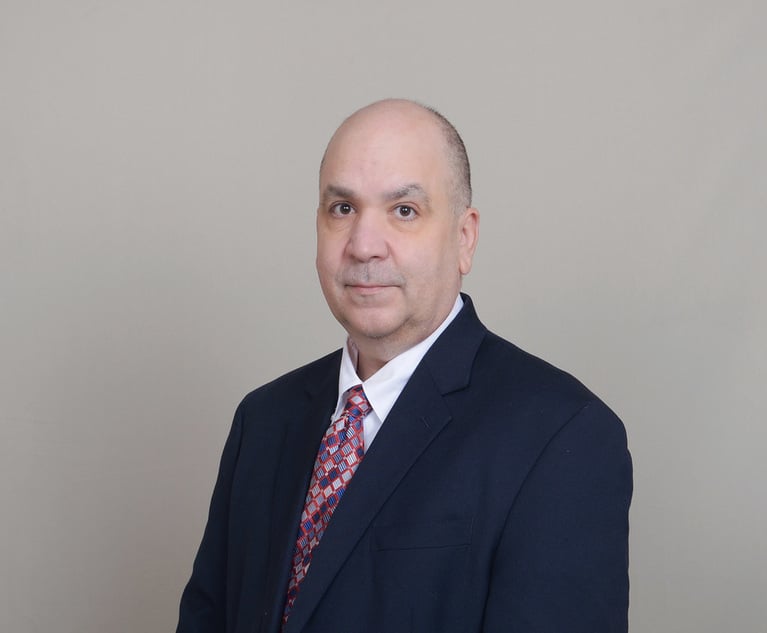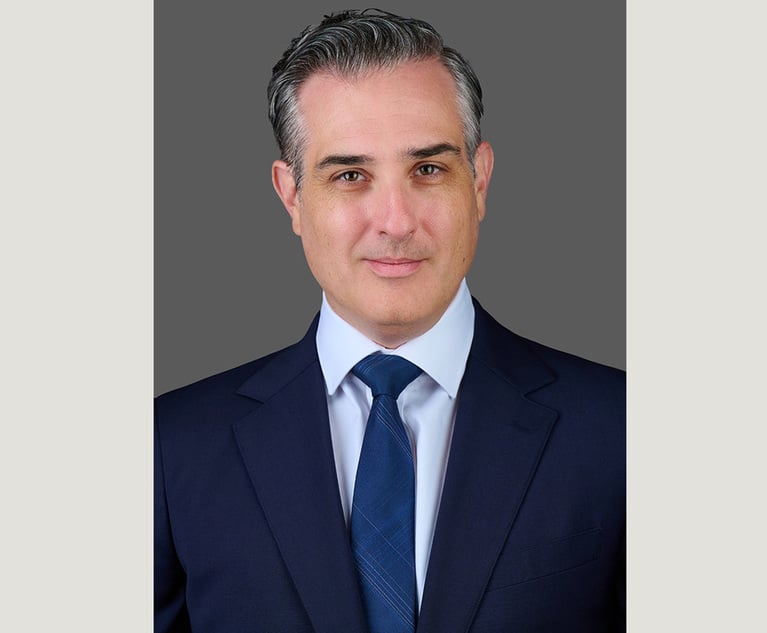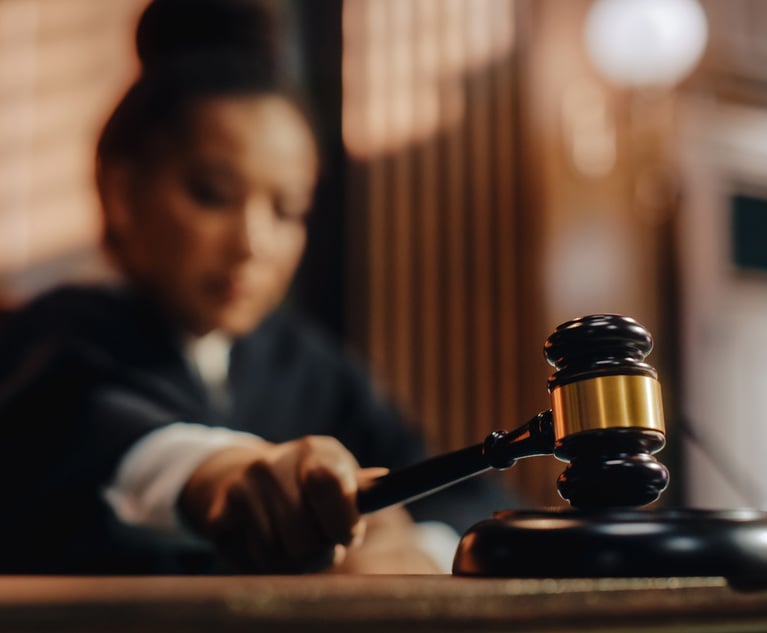 Pittsburgh-based Reed Smith associate Aleksandra Phillips said creating artwork, like this portrait of a former client who was killed, helps her manage the stress of her work. (Courtesy photo)
Pittsburgh-based Reed Smith associate Aleksandra Phillips said creating artwork, like this portrait of a former client who was killed, helps her manage the stress of her work. (Courtesy photo)A Growing Pittsburgh Movement Promotes Art Therapy for Lawyers Battling Stress
A Reed Smith lawyer and others have banded together to promote art therapy for lawyers struggling from stress and anxiety.
November 09, 2018 at 09:57 AM
6 minute read
The original version of this story was published on The American Lawyer
Aleksandra “Sasha” Phillips, a Pittsburgh-based Reed Smith associate who litigates commercial cases, always carries her sketchbook, pencils or paint in her briefcase or suitcase. Phillips, 42, who goes by Sasha, never knows when it might help.
Last year, in a pro bono case, she represented a college student, Alina Sheykhet, in seeking a permanent restraining order against Sheykhet's ex-boyfriend. Within days of a court proceeding in the matter, the ex-boyfriend killed Sheykhet.
Phillips had recurring thoughts about what she could have done differently, even though those scenarios weren't possible. “As a mother of three girls myself, I saw this as my worst nightmare,” she said. “As a lawyer, I could not get away from all the 'what if,' and as a person, I wished there was something I could do, but I didn't even know what to say. So I decided to paint Alina's portrait from a photograph someone handed me at her funeral. The painting process itself was very therapeutic for me—as I was painting it, I was becoming less anxious and sad.”
 A drawing that Phillips made after last month's shooting at the Tree of Life synagogue in Pittsburgh. (Courtesy photo.)
A drawing that Phillips made after last month's shooting at the Tree of Life synagogue in Pittsburgh. (Courtesy photo.)
She gave the portrait to the client's family in January. The mother was appreciative of the portrait, seeing it a message from her daughter, while it brought closure to Phillips herself, she said.
Phillips, who made another drawing after the Pittsburgh synagogue shooting, knows she's not the only attorney one who finds benefits—and sometimes solace—in creating art. Phillips and several other attorneys have banded together to promote art therapy for lawyers struggling from stress and anxiety.
The group hopes to exhibit at the federal courthouse in Pittsburgh and possibly other locations in the city. These community events could feature artwork by lawyers, law students and other professionals in high-stress fields.
For a potential event at the Western District of Pennsylvania federal courthouse, at least 30 attorneys have expressed an interest in exhibiting their artwork, whether drawings, paintings, sculpture or another forms, Phillips said. “The response I'm getting is pretty enthusiastic,” she said.
Judge Nora Barry Fischer, who leads a community outreach effort in the U.S. District Court for the Western District of Pennsylvania, confirmed there are preliminary talks underway to exhibit artwork from attorneys early next year. “It demonstrates another side of the profession,” she said about the potential event.
 Aleksandra (Sasha) Phillips of Reed Smith
Aleksandra (Sasha) Phillips of Reed Smith
Phillips is also in talks with Reed Smith management to have an art therapy wellness month in February, as part of the firm's Wellness Works program to support and sustain the well-being of law firm personnel.
The Reed Smith firmwide program may include a law firm blog featuring lawyer and staff artwork; art exhibits in various offices made by lawyers and staff; art-making classes, such as in painting or music; and possible speeches about using art as a tool for alleviating stress.
Nita Gordon, Reed Smith's U.S. director of human resources, said the firm is still in the early stages of planning the events. “We want to offer something for each office,” she said. “The more we talked about it, the more we realized it would be a really important thing for us to do for our employees.”
Through the firm and community events, Phillips said, she hopes to raise awareness of what “art can do to alleviate stress, to improve well-being.” One integral part of the exhibits, Phillips said, is featuring accompanying statements from the artists to describe how the art helped them or what inspired them.
|Stress Reliever
While attorneys throughout the legal field feel pressured to “do more, bill more, represent more clients, be more aggressive,” Phillips said, multiple studies show the benefits of art therapy, even just doodling. “You don't have to be a great artist” to get the benefit, she said.
Susan Alexander Ott of Owen & Conley and Kathleen Nandan of Leech Tishman Fuscaldo & Lampl, both in Pittsburgh, are among those working with Phillips on planning the community events and might have some of their own artwork as exhibits.
While lawyers don't always share what they do in their spare time, Nandan said, “I think there's more of us out there who are artistic than I might otherwise guess.”
Ott said painting helped her while her mother was ill in an assisted living facility several years ago. “It's a big relaxer for me. It taps into my right brain,” Ott said. “I'm not a judge of whether I'm any good or not. I don't even care—that's the trick of making it work as a stress reliever.”
Another lawyer who could exhibit at the courthouse event is Sara O'Connor, who was a litigator at K&L Gates. She took up painting as a hobby and “as a sort of self-medication” when she was on medical leave from the firm and ultimately left the firm in late 2016 to become a full-time artist. While she occasionally tutors law students, she supports herself by selling her own artwork now.
“It's not that I channel everything out,” she said about how painting helps her. “It's that my mind is able to more clearly sift through [information]. It's a different frequency of focus.”
While various treatment centers use art therapy to help patients, attorney and counselor Patrick Krill said he's not aware of any existing widespread art therapy program for the legal profession. He said it would be worthwhile for other law firms to explore such programs.
“If you think of the role of a lawyer, there's often not a lot of room for emotionality or expression for emotions. We are trained to be detached and dispassionate and to be analytical,” he said. But he added he has observed that the lawyers “who enjoy the greatest state of well-being tend to have some sort of hobby where they're able to engage their creative and emotional self.”
This content has been archived. It is available through our partners, LexisNexis® and Bloomberg Law.
To view this content, please continue to their sites.
Not a Lexis Subscriber?
Subscribe Now
Not a Bloomberg Law Subscriber?
Subscribe Now
NOT FOR REPRINT
© 2025 ALM Global, LLC, All Rights Reserved. Request academic re-use from www.copyright.com. All other uses, submit a request to [email protected]. For more information visit Asset & Logo Licensing.
You Might Like
View All
People in the News—Jan. 9, 2025—Rawle & Henderson, Armstrong Teasdale
3 minute read


Phila. Court System Pushed to Adapt as Justices Greenlight Changes to Pa.'s Civil Jury Selection Rules
5 minute readTrending Stories
- 1Stevens & Lee Names New Delaware Shareholder
- 2U.S. Supreme Court Denies Trump Effort to Halt Sentencing
- 3From CLO to President: Kevin Boon Takes the Helm at Mysten Labs
- 4How Law Schools Fared on California's July 2024 Bar Exam
- 5'Discordant Dots': Why Phila. Zantac Judge Rejected Bid for His Recusal
Who Got The Work
Michael G. Bongiorno, Andrew Scott Dulberg and Elizabeth E. Driscoll from Wilmer Cutler Pickering Hale and Dorr have stepped in to represent Symbotic Inc., an A.I.-enabled technology platform that focuses on increasing supply chain efficiency, and other defendants in a pending shareholder derivative lawsuit. The case, filed Oct. 2 in Massachusetts District Court by the Brown Law Firm on behalf of Stephen Austen, accuses certain officers and directors of misleading investors in regard to Symbotic's potential for margin growth by failing to disclose that the company was not equipped to timely deploy its systems or manage expenses through project delays. The case, assigned to U.S. District Judge Nathaniel M. Gorton, is 1:24-cv-12522, Austen v. Cohen et al.
Who Got The Work
Edmund Polubinski and Marie Killmond of Davis Polk & Wardwell have entered appearances for data platform software development company MongoDB and other defendants in a pending shareholder derivative lawsuit. The action, filed Oct. 7 in New York Southern District Court by the Brown Law Firm, accuses the company's directors and/or officers of falsely expressing confidence in the company’s restructuring of its sales incentive plan and downplaying the severity of decreases in its upfront commitments. The case is 1:24-cv-07594, Roy v. Ittycheria et al.
Who Got The Work
Amy O. Bruchs and Kurt F. Ellison of Michael Best & Friedrich have entered appearances for Epic Systems Corp. in a pending employment discrimination lawsuit. The suit was filed Sept. 7 in Wisconsin Western District Court by Levine Eisberner LLC and Siri & Glimstad on behalf of a project manager who claims that he was wrongfully terminated after applying for a religious exemption to the defendant's COVID-19 vaccine mandate. The case, assigned to U.S. Magistrate Judge Anita Marie Boor, is 3:24-cv-00630, Secker, Nathan v. Epic Systems Corporation.
Who Got The Work
David X. Sullivan, Thomas J. Finn and Gregory A. Hall from McCarter & English have entered appearances for Sunrun Installation Services in a pending civil rights lawsuit. The complaint was filed Sept. 4 in Connecticut District Court by attorney Robert M. Berke on behalf of former employee George Edward Steins, who was arrested and charged with employing an unregistered home improvement salesperson. The complaint alleges that had Sunrun informed the Connecticut Department of Consumer Protection that the plaintiff's employment had ended in 2017 and that he no longer held Sunrun's home improvement contractor license, he would not have been hit with charges, which were dismissed in May 2024. The case, assigned to U.S. District Judge Jeffrey A. Meyer, is 3:24-cv-01423, Steins v. Sunrun, Inc. et al.
Who Got The Work
Greenberg Traurig shareholder Joshua L. Raskin has entered an appearance for boohoo.com UK Ltd. in a pending patent infringement lawsuit. The suit, filed Sept. 3 in Texas Eastern District Court by Rozier Hardt McDonough on behalf of Alto Dynamics, asserts five patents related to an online shopping platform. The case, assigned to U.S. District Judge Rodney Gilstrap, is 2:24-cv-00719, Alto Dynamics, LLC v. boohoo.com UK Limited.
Featured Firms
Law Offices of Gary Martin Hays & Associates, P.C.
(470) 294-1674
Law Offices of Mark E. Salomone
(857) 444-6468
Smith & Hassler
(713) 739-1250





